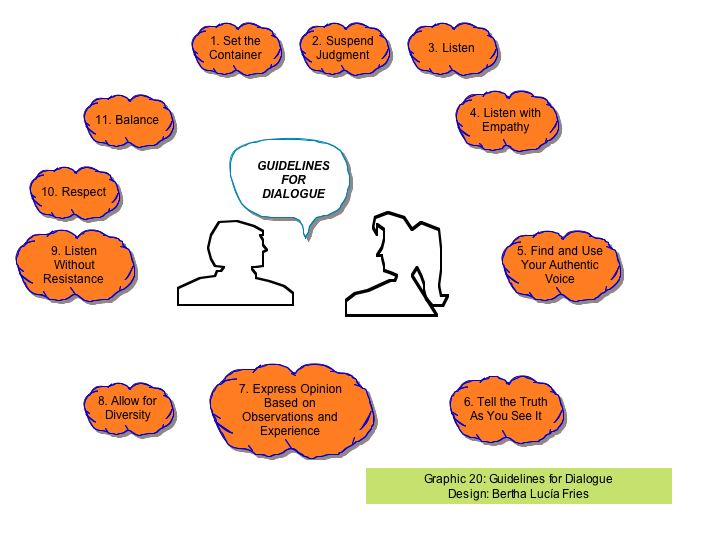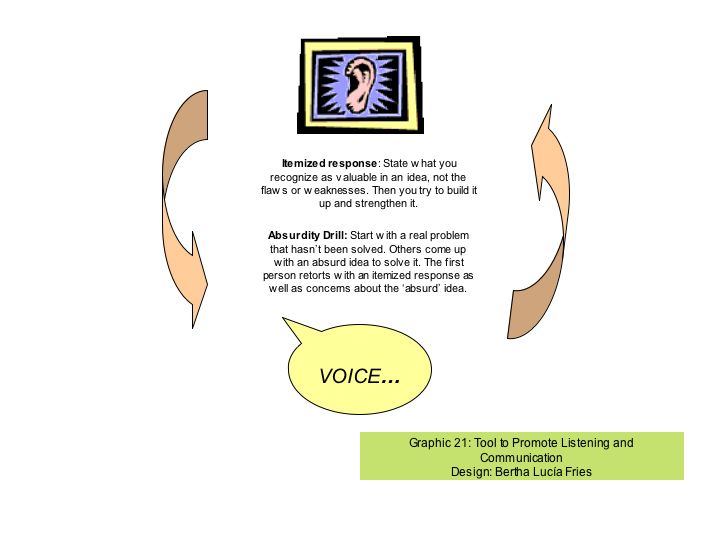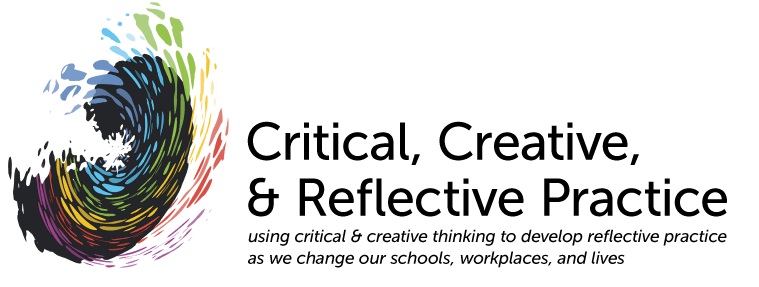Dialogue
(See Graphic 20)
WHAT is it? Dialogue is a special kind of conversation that brings out the inner wisdom of both the individuals who participate and the collective thinking of the group. Dialogue is not a rehearsed speech; it is spontaneous, seeking new ideas that are created in the moment.
WHO is it for? Dialogue is for those who want to develop and value the art of thinking together or a group that wants to explore what might emerge through extended dialogue together. It can be used in many kinds of setting including work and business environments. Dialogue is dependent on empathy and through this opens perspectives and ideas to higher levels.
WHY use this method? In making our thinking process visible we help others understand where we’re coming from and give them the opportunity to help us clarify our thinking. When assumptions are revealed we become more aware of them, what they are based on and can check out their validity. By making our beliefs overt we can observe them more clearly and by relating them to our thinking process determine whether these should be cherished or trashed. Beliefs include our attitudes, deep feelings and convictions. All this makes up our individual contribution to the shared meaning that emerges or unfolds with the dialogue group from the larger pattern
Guidelines for Dialogue
1. Set the Container – One of the most important dimensions of dialogue is the atmosphere in which it occurs. We cannot manufacture an atmosphere but we can create conditions under which a rich atmosphere for interaction is more likely to appear. Containers take many forms and you want to create a place where energy, possibility and safety exist. Physical components such as acoustics, lighting, noise, distractions and comfort are important. Sitting in a circle encourages full participation.
2. Suspend Judgment – This does not mean you must give up your judgments but you are asked to become aware of them. You neither suppress what you think nor advocate for it, instead you recognize what you think and display your thinking in a way that lets yourself and others see and understand it. Hold convictions lightly, look at them critically and perhaps let them go. This allows your thinking to become more open and shared. Talk about your beliefs, assumptions and how you arrived at your conclusions. Much of our reaction to others comes from our own stored reaction is not a fresh response. Access your ignorance and place emphasis on the learning rather than the knowing.
3. Listen - Most of us, despite our best intentions, tend to spend our conversational time waiting for the first opportunity to offer our own comments or opinions. People do not listen, they reload! The heart of dialogue is a simple but profound capacity to listen. Listening requires we not only hear the words, but also embrace, accept and gradually let go of our own inner clamoring. To listen is to develop an inner silence. You need to cultivate a place inside yourself and with others where listening can occur.
4. Listen with Empathy – Listen as an ally in a cooperative mode rather than as a competitor. Really listen for understanding of others’ feelings and do not necessarily relate them back to your own experiences. Honor their experience as unique. Assume good intent on their part and hear them out without interruptions.
5. Find and Use Your Authentic Voice – Speaking your voice has to do with revealing what is true for you regardless of other influences. Your authentic voice is not a rehash of other words and we are unlikely to find someone else speaking what we ourselves need to say. There is a risk when speaking with your authentic voice that you will be ridiculed, judged, listened to or respected. Only as you learn to take seriously the possibility that what you think might be in fact valid for others do you find the confidence to share it. Finding and speaking your voice entails feeling the confidence that what you are thinking is valid and fits.
6. Tell the Truth As You See It – We need to distinguish between the inferences we make about experience and the actual experience itself. Look at the directly observable data and notice how data is manipulated by different standards. When we are invested in an opinion, we tend to seek evidence that we are right and avoid evidence that we are wrong. We jump to conclusions all the time and many of us assume this is an acceptable way of conducting ourselves: to set things up in an oppositional fashion, draw sharp conclusions and let things fall where they may. We do not stay in touch with our experience but draw abstract inferences from it, and then we assume our inferences ARE the reality.
7. Express Opinion Based on Observations and Experience - Stick to the facts. Listen with a great deal more humility by connecting what you think with the experiences that lead you to think it. We are not always aware of the extent to which our assumptions color our thinking. The main emphasis must be on your own opinions therefore use “I” as a central part of your language.
8. Allow for Diversity – Let diversity of thought enrich the quality of dialogue. Often when we listen to others we may discover we are listening from disturbance, in other words we are listening from an emotional memory rather than the present moment. Be present in the moment and look for the meaning that emerges from the group thinking together.
9. Listen Without Resistance – We can learn to listen in way that recognizes and then puts aside the resistances and reactions that we feel to what someone else is saying. You don’t have to agree or disagree, just understand and try to learn from what others are saying. Become conscious of the ways in which you project your opinions about others onto them or how you may color or distort what is said without realizing it.
10. Respect – At its core the act of respecting invites us to see others as legitimate. Do not argue, analyze, nit pick or give advice. Respect is not a passive act, it takes energy. We may not like what others do or say or think, but we cannot deny their legitimacy as beings. Respect also means honoring people’s boundaries to the point of protecting them. You do not intrude while at the same time you do not withhold yourself or distance yourself from them. When we respect someone, we accept that they have things to teach us and we respect them for the potential they carry within them.
11. Balance -– Good dialogue has the right balance between advocacy and inquiry. Advocacy is your opinion and is usually expressed in the statements you make. Inquiry is seeking understanding and usually expressed in the questions you ask. Asking open ended questions (“what are your assumptions?”) gets to the heart of the matter and helps the person think more clearly. Coherence is the balance between paying attention to the details, those that matter to you or irritate you, and being able to step back from the details, soften your focus and hear what is going on in the overall space of the conversation.

Adapted from Bradford (2004) and Isaacs (1999)
Listening with Empathy
1. Learn to still the voices within. You can’t listen well if you are rehearsing your next speech.
2. Tune into the other person’s feelings. You can see their feelings in their facial expression and hear them in their tone of voice.
3. Make eye contact and focus your attention on what they are saying.
4. Let trouble attract help. Look for ways to reach out to the other person and offer support where needed.
5. Be sensitive to how the other person is trying to put their thoughts together. Hear them out without interruptions.
6. Look for what is of value as you listen. Do not attack the weakness in what they are saying rather look for the strengths.
7. Assume good intent.
8. Look for the implications in what is said. Find out what these implications mean for you and others.
9. Be prepared to put in your own words what the other person has said and to state it back to confirm that you heard them correctly.
10. Realize that you don’t have to agree with what was said to listen well, but you do have to understand it clearly.
11. Be curious toward ideas that seem to be unfamiliar and even strange. These may lead to new insights and learning.
12. Pay attention to how you listen. Try listening as an ally in a cooperative mode, rather than as a competitor.
Tool to get dialogue flowing
Start with one question. Each person answers the question asked to them in statement form then asks another question to the next person. This helps get the dialogue juices flowing and allows people comfortable with the dialogue concept.
Source: Bradford (2004)
Tool to promote listening and communication
Source: Bradford (2004)Itemized response – State what you recognize as valuable in an idea, not the flaws or weaknesses. Then you try to build it up and strengthen it.
Absurdity Drill – Start with a real problem that hasn’t been solved. Others come up with an absurd idea to solve it. The first person retorts with an itemized response as well as concerns about the ‘absurd’ idea.

Dialogue as a creative exploration
- Dialogue is a conversation with a center, not sides. It is a way of taking the energy of our differences and channeling it toward something that has never been created before. It fulfills deeper, more widespread needs than simply “getting to yes”. Dialogue seeks addressing the problem of fragmentation not by rearranging the physical components of a conversation but by uncovering and shifting the organic underlying structures that produce it. A conversation could in itself somehow lead people past their natural defenses into genuine contact with one another and a more invisible, implicate reality. Because of its tendency to decompose issues, discussion leads us to look for those parts of problems that are already known. Dialogue, in contrast, asks us to consider the context or field in which the problem arises, to open ourselves to new options and the thinking underlying our assumptions, not simply to go for closure. Discussion is about making a decision; dialogue is about exploring the nature of choice.
Source: Kaparo (2004)
More ideas to keep in mind when practicing Dialogue
- An idea is fragile when it first emerges. If it’s judged it will retreat and parish, it needs to be nourished in order to let it grow. We need to support it in order for it to develop.
- When we are creating or inventing we need to experiment over and over. We may not be able to articulate, we may only have an inkling, eventually we may come to a point where we can speak of it after it’s been nourished. This happens in dialogue.
- 3 ways we communicate – verbal, non-verbal and tone. Our tone is subjective and we don’t hear our own tone of voice as well as others hear it.
- As art of thinking together, we don’t always think privately, we can think overtly and visibly. We can ask for thinking help and also aid others in thinking. We are usually not aware of our own assumptions but others can see it more clearly.
- Shouldn’t get too polite or too intellectual.
- You have to listen to yourself as much as others.
- The way one observes creates the reality. We see through our own filters and constructs. I participate in creating the meaning. Others may see it differently and therefore it is subjective yet there is collectivity.
- Dialogue is a practice. Practicing thinking together. The more you practice the better you get at it and the better you get at thinking.
- There is a deeply communal dimension to speaking together that is typically lost on us. Speaking can be creating, not simply something that reveals our thoughts.
Source: Kaparo (nd)
References
(to be completed)(Original page by Mary Frangie)
